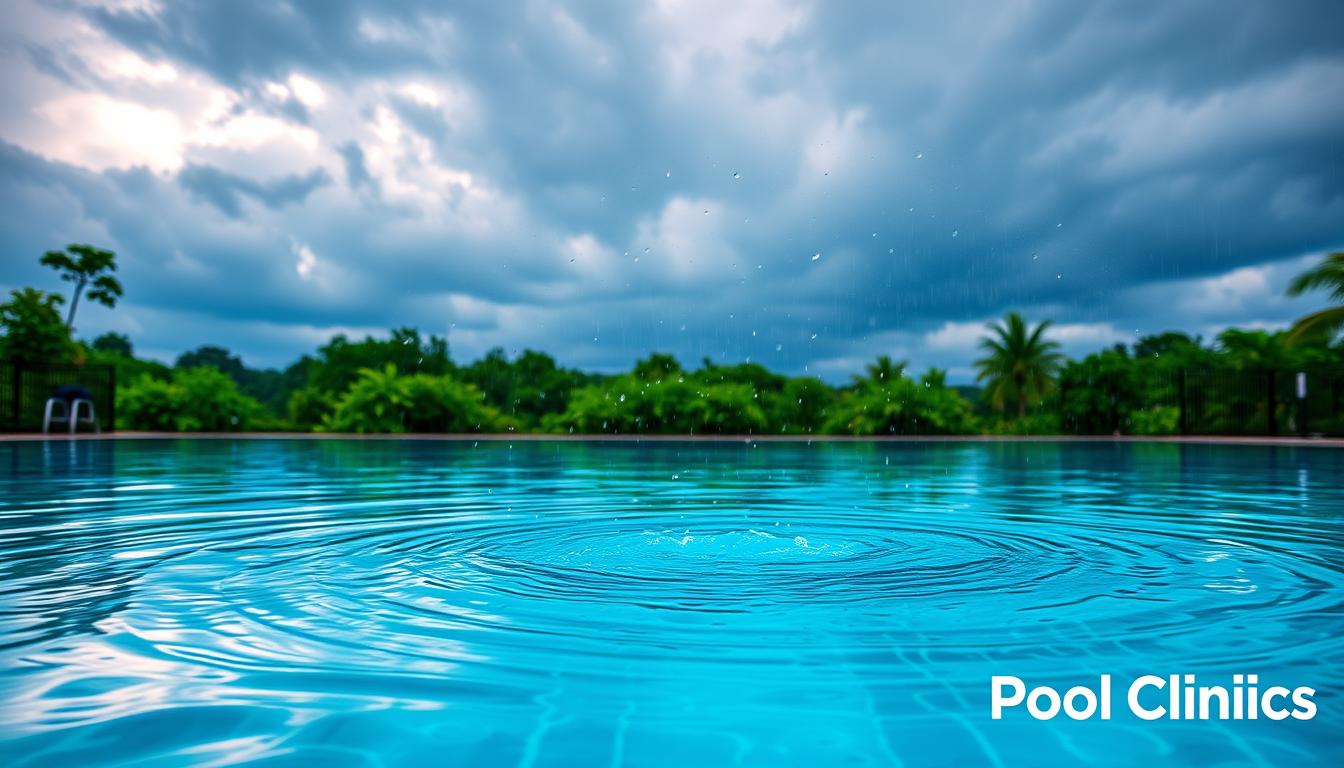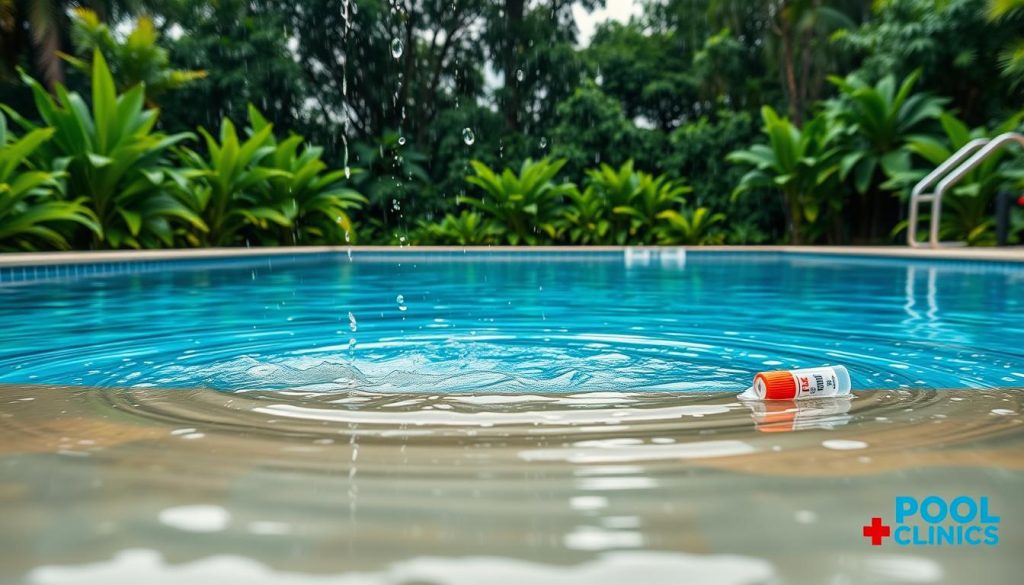
Rain can disrupt your pool plans and affect water quality. Rainwater’s acidity and contaminants can upset the chemical balance you’ve worked hard to maintain. This can make your pool unsafe for swimming.
Imagine hosting a fun pool party when dark clouds appear. A heavy thunderstorm hits your backyard oasis. The rain cools things down but adds acidic water to your pool. This can cause big changes in pH levels that need quick fixing.
Rain brings more than just water. Wind can blow leaves and twigs into your pool. These add phosphates and nitrogen that help algae grow. Runoff from decks or lawns can bring dirt and chemicals. This can make your pool dirty and cloudy.
We’ll explore how rain affects pool water quality and safety. We’ll look at chemical changes, possible risks, and how long to wait before swimming. You’ll learn expert tips for keeping your pool healthy during rainy seasons.
Our goal is to help you enjoy your pool safely. We’ll show you how to keep it clean and fun, no matter the weather.
Key Takeaways
- Rain can significantly impact pool water chemistry, leading to pH fluctuations and reduced chlorine effectiveness.
- Rainwater can introduce contaminants like dirt, phosphates, and organic debris into pools, promoting algae and bacteria growth.
- It’s essential to monitor and adjust chemical levels before and after rainfall to maintain a safe swimming environment.
- Waiting at least 30 minutes to several hours after rain before swimming is recommended, depending on the intensity of the downpour.
- Regular cleaning, balancing water levels, and shocking the pool when necessary are crucial for maintaining pool health during rainy seasons.
Effects of Rain on Pool Water Chemistry
Rain can upset the chemical balance of pool water, creating health risks. Heavy rainfall dilutes chlorine, making it less effective at killing bacteria and algae. This can lead to cloudy water and increased algae growth.

Chemical Dilution and pH Fluctuation
Rain dilutes pool chemicals, especially chlorine. This reduces chlorine’s ability to keep the pool clean and safe. As a result, bacterial growth may increase, posing health risks to swimmers.
Rainwater can also affect the pool’s pH level. It’s naturally acidic, with a pH between 5.0 and 5.5. Large amounts of rain can lower the pool’s overall pH level.
Low pH can irritate swimmers’ eyes and skin. It may also corrode metal pool components like ladders and handrails.
The ideal pH range for pool water is between 7.2 and 7.6. However, rain can lower the pool pH to a range of 6.2 to 4.3, which is considered slightly to moderately acidic.
Reduced Chlorine Effectiveness
Rain not only dilutes chlorine but also makes it less effective. Lower chlorine levels struggle to sanitize the pool properly. This can result in cloudy water and increased risk of bacterial and algal growth.
Low chlorine can cause skin and eye irritation. It may also lead to waterborne infections. Regular testing and adjusting of chlorine levels is crucial, especially after heavy rainfall.
Algae and Bacteria Growth
Rain can bring contaminants like dirt and debris into the pool. These create an environment where algae and bacteria thrive. Diluted chlorine is less effective at preventing algae growth.
Sunlight speeds up algae growth, leading to green, slippery surfaces. Changed pH and chlorine levels can also promote mold and mildew growth. This poses health risks, especially for those with allergies or breathing issues.
| Contaminant | Effect on Pool Water | Prevention/Treatment |
|---|---|---|
| Dirt and debris | Cloudy water, clogged filters | Regular cleaning and skimming |
| Algae spores | Green, slippery surfaces | Maintaining proper chlorine levels, using algaecides |
| Bacteria | Waterborne infections, skin irritation | Ensuring adequate sanitizer levels, regular testing |
| Mold and mildew | Unsightly patches on tiles and surfaces | Maintaining balanced water chemistry, regular cleaning |
To reduce rain’s effects on pool chemistry, regular maintenance is key. This includes testing and balancing water after heavy rainfall. Adjusting pH, chlorine, and alkalinity levels helps restore balance.
- Testing and balancing the pool water after heavy rainfall
- Adjusting pH, chlorine, and alkalinity levels to restore balance
- Performing shock treatment to oxidize contaminants and restore chlorine levels
- Regularly cleaning and removing debris introduced by rain
- Ensuring proper maintenance of pool equipment, such as pumps and filters
Understanding rain’s impact on pool chemistry is crucial. Effective maintenance practices can minimize contamination risks. This ensures a safe and enjoyable swimming experience for everyone.
Is It Safe to Swim in a Pool After Rain?
Pool safety is crucial after a rainstorm. The wait time depends on the storm’s intensity and your pool’s condition. Assessing water quality is vital for a safe swim.
Rainwater in the US is often acidic. It can affect pH, alkalinity, and other pool water levels. It may also dilute sanitizers, including salt in saltwater pools.
Runoff from yards or decks can unbalance pool water. Debris and lightning can also impact water quality. Testing pool water after a big storm is important.
Monitor chlorine and sanitizer levels to prevent cloudiness or algae. A shock treatment may be needed if the chemistry is off. Drain the pool to correct levels before shocking.
“Swimming in a pool after a rainstorm without proper water testing and treatment can expose swimmers to various health risks, including infections and illnesses caused by harmful bacteria and germs.”
Consider these factors when deciding when to swim after rain:
- The amount of rainfall and the intensity of the storm
- The condition of your pool and its filtration system
- The results of water chemistry tests
- The presence of debris or contaminants in the pool
| Rainfall Intensity | Recommended Waiting Time |
|---|---|
| Light rain (less than 0.5 inches) | 2-4 hours |
| Moderate rain (0.5-1 inch) | 4-6 hours |
| Heavy rain (more than 1 inch) | 6-12 hours or until water chemistry is balanced |
Follow these pool safety guidelines after rain. Wait the recommended time before swimming. This ensures a safe and fun experience for everyone.
Always prioritize water quality and pool health. This prevents risks from swimming in contaminated water.
Conclusion
Keeping a pool clean and healthy requires regular care. This is especially important after heavy rain. Key tasks include skimming debris, cleaning filters, and brushing pool surfaces.
Proper pool cover use prevents contamination during rainy periods. Efficient drainage systems help manage rainfall without constant water removal. These steps prevent algae growth and water imbalance.
Pool safety is crucial. Disconnect electrical and gas lines during storms. Store outdoor furniture securely. Test and balance pool water after draining excess rainwater.
Reduce drowning risks by enrolling children in swimming lessons. Ensure close adult supervision and use life jackets. Be aware of medical conditions that may affect water safety.
Consistent care and safety measures allow worry-free pool enjoyment. Consult professional pool services if you need expert guidance. With the right approach, your pool can be a fun oasis in any weather.







